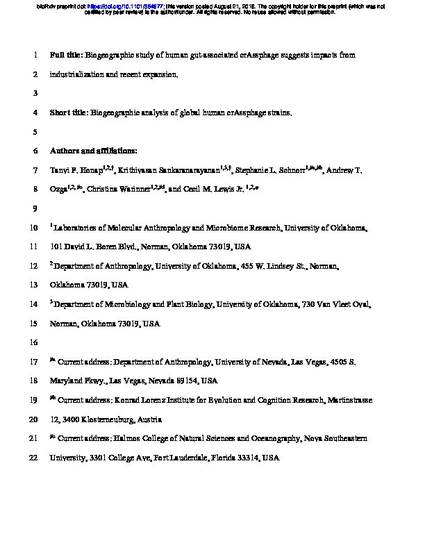
CrAssphage (cross-assembly phage) is a bacteriophage that was first discovered in human gut metagenomic data. CrAssphage belongs to a diverse family of crAss-like bacteriophages thought to infect gut commensal bacteria belonging to Bacteroides species. However, not much is known about the biogeography of crAssphage and whether certain strains are associated with specific human populations. In this study, we screened publicly available human gut metagenomic data from 3,341 samples for the presence of crAssphage sensu stricto (NC_024711.1). We found that crAssphage prevalence is low in traditional, hunter-gatherer populations, such as the Hadza from Tanzania and Matses from Peru, as compared to industrialized, urban populations. Statistical comparisons showed no association of crAssphage prevalence with variables such as age, sex, body mass index, and health status of individuals. Phylogenetic analyses show that crAssphage strains reconstructed from the same individual over multiple time-points, cluster together. CrAssphage strains from individuals from the same study population do not always cluster together. Some evidence of clustering is seen at the level of broadly defined geographic regions, however, the relative positions of these clusters within the crAssphage phylogeny are not well-supported. We hypothesize that this lack of strong biogeographic structuring is suggestive of a recent expansion event within crAssphage. Using a Bayesian dating approach, we estimate this expansion has occurred within the past 200 years. Overall, we determine that crAssphage presence is associated with an industrialized lifestyle. The absence of strong biogeographic structuring within global crAssphage strains is likely due to a recent population expansion within this bacteriophage.
Available at: http://works.bepress.com/andrew-ozga/41/
